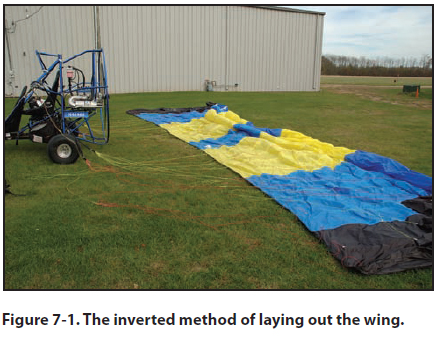|

Most powered parachute incidents occur during the
takeoff. This is because unlike most other types of aircraft,
a powered parachute needs to create the airfoil
before flight can be attempted. This critical process
happens during the takeoff roll. The importance of
thorough knowledge, faultless technique, and judgment
cannot be overemphasized.
Terms and Definitions
Although the takeoff and climb is one continuous maneuver,
it will be divided into four separate steps for
purposes of explanation:
Equipment staging the portion of the
takeoff procedure during which the powered
parachute is positioned and the chute is set up
for takeoff.
Takeoff roll (ground roll) the portion of the
takeoff procedure during which the powered
parachute is accelerated from a standstill to an
airspeed that provides sufficient lift for it to
become airborne.
Rotation and liftoff enough lift is on the
wing to rotate the nose wheel and lift the
powered parachute off the ground.
Initial climb begins when the powered
parachute leaves the ground and a rate of climb
is established.
Normally, the process is considered complete when
the powered parachute has reached a safe maneuvering
altitude, or an enroute climb has been established.
Laying Out the Wing
Refer to Chapter 5 to understand wing inspection, a
separate procedure from wing layout. There are several
ways to successfully lay out a powered parachute
wing. What an instructor teaches is usually determined
by the terrain, wind conditions, wing shape, and personal
preference. There are two major layout methods:
the inverted method and the stacked method.
The Inverted Method
The inverted method of laying out a wing involves
spreading it out with the bottom surface of the wing
facing up like a blanket on the beach. [Figure 7-1] The
trailing edge of the wing is positioned closest to the
cart and the leading edge is pulled out as far behind
the cart as it will lay without pulling the cart backwards.

This method allows for a clear inspection of the wing
and the attachment points of the suspension lines. It
also allows the propeller blast on most carts to go over
the wing, keeping it from inflating too early.
The main advantage to the inverted method is that
when the cart rolls forward on the takeoff roll, it
pulls the leading edge (A-lines) before it pulls the
other suspension lines. This allows for a quick inflation
of the wing. However, the inverted method
is prone to lifting at the edges of the wing when
there is wind. The wind can get under the corners
of the wing and blow it up and back before you are
ready to take off which can delay the proper inflation
of the wing during the takeoff roll. Keep in mind
that if the wind is blowing hard enough to lift the
wing from its layout position, the flight conditions
should be reviewed before continuing with the flight.
|

